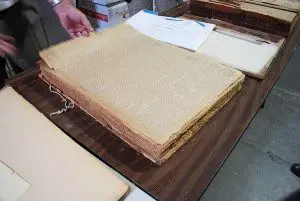Preserving History through Newspaper Digitization, Part One
For years, the spoken word was the primary method with which people conveyed thoughts and ideas, did business, and broadcasted the

day’s events. This system was not extremely efficient or particularly accurate. It could take quite some time for news to travel and, often the day’s news would change from its inception throughout its travels. Remember playing the game “Telephone” as a child? As history evolved oral tradition gave way to the written language.
Scribes, historians and those with an education could now transcribe the day’s events for others to read and enjoy. The process was meticulous but it provided more accurate records and allowed information to travel further, faster. Then something happened that would forever change the world of communication.
In 1450 Johannes Gutenberg invented the printing press, making information more quickly and readily available to the masses. The newspaper fast became a predominate source for information.
Preserving History through Newspaper Digitization
While the Internet has all but made today’s newspapers obsolete, the history contained within the pages of newspapers past is incredibly important to preserve. Thanks to the written word, we now have a much better understanding of the economic, political, cultural and social history of the world. This is why many archives and museums are doing everything they can to preserve that history through digitization.
Paper is inherently fragile and subject to deterioration, digital media – in theory – will never decay and break down. (Of course, for long-term security, we encourage the microfilming – or archive writing – of these digital images just in case the world does tilt on its axis and all those computer magnets go awry! Read our blogs on the relevance of microfilm). When digitized, this valuable information can be placed online for widespread distribution and access to all. For these reasons, the Library of Congress and the National Endowment for the Humanities have developed the National Digital Newspaper Program (NDNP). Over a 20-year period, the NDNP will work towards creating a national database of historically significant newspapers published between 1836 and 1922 from across the country. This free, searchable database, “Chronicling America: Historic American Newspapers,” is available online and permanently maintained by the Library of Congress. The database currently provides access to more than 2.6 million digitized pages, with tens of millions of pages to eventually be available.
The Crowley Company: Helping preserve History through Newspaper Digitization
Since its inception more than 30 years ago, Crowley Imaging has earned the respect of renowned archivists and institutions, including the Smithsonian Institution, the Library of Congress and many others, for our analog and digital preservation services. Specific to newspaper digitization, Crowley Imaging has scanned between five and 10 million images of newspapers dating back to the early 1800s. Crowley’s manufacturing and hardware division also provides microfilm and overhead scanning equipment to service bureaus, libraries and collections worldwide for the purpose of newspaper preservation.
Check back next week as we delve further into newspaper preservation and take a look at some of the work Crowley Imaging has done recently, including the digitization of the Carroll County Times. In the meantime, if you have any questions about Preserving History through Newspaper Digitization , please contact The Crowley Company by calling (240) 215-0224. General inquiries can be emailed to [email protected]. You can also follow The Crowley Company on Facebook, Twitter, Google+, LinkedIn, Pinterest, and YouTube.
Sources:
Bringing Historic Newspapers to Your Desktop: The National Digital Newspaper Program
